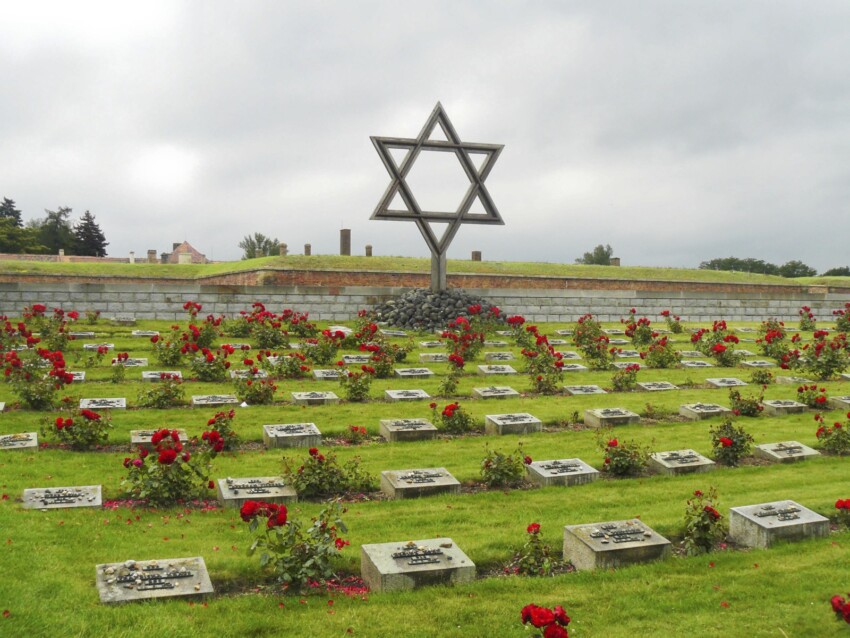
It is curious how the historical events of Terezín have inextricably linked a woman’s name to one of the most dramatic chapters of contemporary history: the Theresienstadt concentration camp.
The town of Terezín was desired as a defensive fortress by Emperor Joseph II, who gave it the name Theresienstadt (town of Theresa, Terezín in Czech) in honour of Empress Maria Theresa of Austria. Built for the purpose of keeping the enemy out, it ironically and sadly went down in history for the people who were forcibly left inside: first political prisoners and then Jews.
It is certainly not as enchanting as other Bohemian cities with their fairy-tale postcard atmospheres, but Terezín is a deeply evocative city and will touch the deepest chords of your heart. Visit it respectfully in silence.
Terezín was built at the end of the 18th century and the plan called for two distinct poles, the Small Fortress and the Big Fortress, which are still preserved today.
At the end of the 19th century the Terezín garrison was abandoned and the Small Fortress was converted into a prison for political opponents of the Habsburg dynasty. Several Russian patriots and deportees from the First World War were imprisoned inside. Gavrilo Princip, the murderer of the Austrian archduke heir to the throne and his wife, who initiated the events that triggered World War I, died in this prison.
In 1940 the Nazis began using the Small Fortress of Terezín as a prison and from the following year the Jews living in the Big Fortress were forcibly transferred to what had become a transit camp to the extermination camps of Germany and Poland; the deportation to Terezín of Jews from other countries then began, again as an intermediate stage of a grim journey.
The numbers are impressive. In September 1942 the population of the ghetto reached the exorbitant figure of over 50,000. It is estimated that in the course of the war about 140,000 Jews were deported to Terezín, of whom 87,000 were actually transferred to other camps. About 35,000 people died inside the ghetto due to illness, malnutrition and suicide.

Start your historical exploration at the Ghetto Museum, where you can learn more about the history of Terezín and the inhuman living conditions of the ghetto inhabitants. It is divided into two locations.
The main building was built in the 19th century to house the local school and later used by the Nazis as a concentration camp for boys aged 10 to 15. Their drawings hang on the walls of the museum as a reminder of the atrocities these boys had to endure. The museum exhibition illustrates the rise of Nazism and daily life in the ghetto, with a collection of everyday objects from the period.
The other exhibition is housed in the former Magdeburg barracks, which was used by the Jews of the ghetto as the seat of their ‘town council’. You can visit a reconstruction of a dormitory as well as evidence of the cultural life that flourished within the ghetto.
Now visit the Small Fortress, where you can see with your own eyes prison barracks, isolation cells, work camps, morgues, mass graves. The motto at the entrance ‘Work makes you free’ (Arbeit Mach Frei in German) sounds ominously ironic considering what awaits you once you pass through the entrance arch.
The anonymous remains of a railway junction that brought, and sent, new prisoners here can be seen south of the main square in the Great Fortress.
To best discover the history of the ghetto, we recommend taking a guided tour from Prague.
To see a completely different Terezín, immersed in a joyful festive atmosphere, visit it in October during the hugely popular Josephine Festival, the largest 18th-century historical re-enactment in Europe.
The Great Fortress encloses what is now the city centre. Don’t expect the splendour of the picturesque Bohemian towns with their colourful little houses, but check out the neoclassical buildings overlooking the main square and the Resurrection Church built in the 19th century.
For a view of the city from a different perspective, you can take a tour of the fortifications and underground tunnels.
Terezín lies 60 km north of Prague and can be easily reached by direct bus in one and a half hours.
City Card allow you to save on public transport and / or on the entrances to the main tourist attractions.
